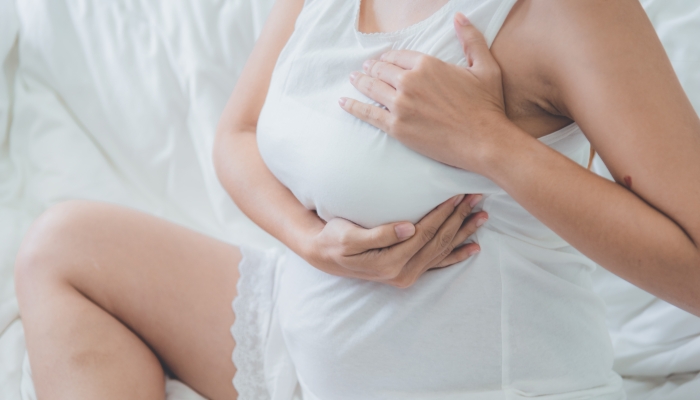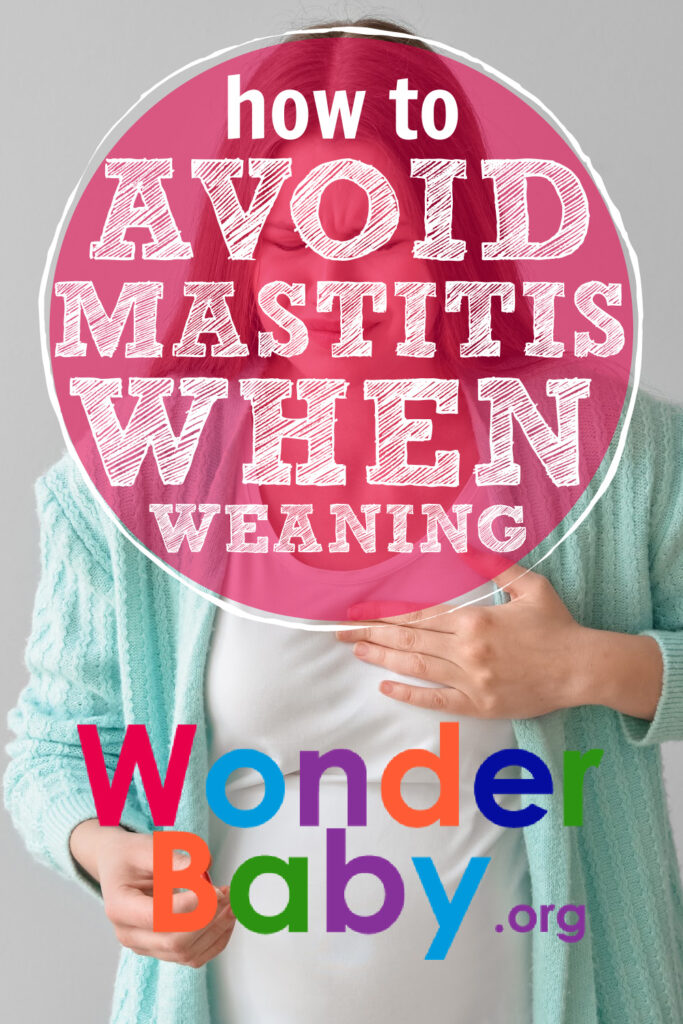How to Avoid Mastitis When Weaning

- Mastitis can happen more often in weaning mothers because of shortened or missed breastfeeding sessions.
- There are many ways to help relieve pain associated with mastitis.
- Wean slowly to help avoid mastitis.
Deciding when to stop nursing your child is perhaps one of the hardest decisions to make when breastfeeding.
Sometimes your body decides for you when weaning occurs, as your milk supply ceases to be enough to keep up with a growing baby.
Other times, parents themselves are the ones to initiate that decision. Returning to work, an illness or treatment process that necessitates ending breastfeeding, or simply a desire to stop are all equally valid reasons to start the process of weaning a breastfed baby.
Several questions may arise as you enter this new phase of your child’s life. How do you stop milk production? Is it painful? How do you avoid mastitis when weaning?
How Does a Mother’s Body Make Milk?
The human body makes milk through a complex interplay between the bodies of the baby and the mother. The mother’s brain receives hormonal signals through the stimulation of glands in the breast tissue that generate milk production. The body stores breast milk in ducts within the breast, where it is squeezed out through the nipple during a pumping or breastfeeding session.
Does Weaning Cause Mastitis?
Weaning can cause mastitis, but it isn’t the only reason.
Since mastitis can be caused by infection of an unrelieved clogged duct, there may be several situations in which a duct becomes blocked, such as hormonal changes or an overabundant milk supply (engorgement).
However, mastitis more typically occurs in weaning mothers because of decreased or eliminated breastfeeding or pumping sessions that occur as part of the process of ending breastfeeding,
When weaning from the breast happens with other changes, like the introduction of solid food or infant formula, your baby may be less interested in breastfeeding because of a fuller belly. Thus, the next time they come to the breast, the blocked ducts may restrict milk flow.
This can lead to less milk received by your baby during a breastfeeding session and intense pain for you. A vicious cycle of blocked ducts, pain, and grumpy babies can then occur, resulting in a frustrating end to the breastfeeding journey for you and your child.

Symptoms of Mastitis After Stopping Breastfeeding
A blocked duct can form at any point during breastfeeding and in one or both breasts. Mastitis occurs when the breast milk in the plugged duct becomes infected by bacteria that enter the skin through tiny cracks in the breast or nipple. Many breastfeeding mothers with mastitis report symptoms such as:
- Fever (greater than 100.4℉)
- Red, hot breasts
- Flu-like symptoms (such as shivering, chills, or body aches)
- Pain or burning sensation with breastfeeding
- Red streaks on the affected breast
Contact your doctor if you suspect that you’ve developed mastitis. Prompt antibiotic treatment is usually indicated to prevent complications, such as a breast abscess.
How Long Does Mastitis When Weaning Last?
With prompt recognition and treatment, mastitis usually clears up in about ten days but can last as long as 2–3 weeks. It’s not unusual to have lumpy breasts for a few days after finishing treatment for mastitis.
How to Treat Mastitis Caused by Weaning
Mastitis is a serious infection with the potential for complications. Proper medical attention and treatment with antibiotics are needed to fully cure the infection.
While you’re waiting for the medication to start working, consider trying the following suggestions to help reduce the painful inflammation associated with mastitis.
- Cabbage leaves. Though research doesn’t tell us how they work, numerous studies have been done that show cabbage leaves applied to the breasts help women with mastitis feel better. Leaves can be hot, chilled, or frozen.
- Warm compresses. Using a warming pad with gentle massage can help relieve and open the blocked ducts.
- Pain medication. Mastitis can be extremely painful. Many medications are available to help—and most don’t require a prescription.
Tips on How to Wean Properly to Prevent Mastitis
Weaning may be unpleasant emotionally, but it doesn’t have to be miserable physically. Consider trying the following solutions for a safer weaning process when winding down your breast milk production.
Wear a Support Bra
A snug, supportive bra may provide structural comfort as you work to stop breastfeeding. When gravity adds weight and pressure to overly full breasts, a tight bra can help counteract those effects.
Express Milk
A lactation consultant or breastfeeding specialist may recommend expressing milk by hand (manual expression) to relieve pressure in your breasts during the weaning process. You can also use a breast pump.
To hand express milk, gently massage or squeeze your breast, releasing just enough milk to help relieve the pressure. Repeat on the other side as needed.
Again, the main idea of manual expression in this situation is to relieve the pressure of overly full and sore breasts. This is why breastfeeding specialists encourage hand expression for a few minutes (until your breasts feel softer) instead of longer periods that completely empty the breast.
Try a Cold Compress
Using cold between feedings can help reduce the swelling and inflammation associated with mastitis. Many breastfeeding mothers find relief from cold packs, which can be tucked in your bra against particularly sore areas.
One lactation consultant I know recommends using frozen peas or corn in small bags inside the support bra. The benefits of this method include being able to reuse the frozen vegetables for new ice packs, fewer worries about water leaking from the bag, and being more flexible and soft than regular ice cubes.
Follow Your Baby’s Lead
If possible, try to make weaning your baby from the breast a slow process rather than a sudden one. Gradually eliminating breastfeeds allows time for you and your baby to adjust physically and emotionally.
A simple way to start weaning is by eliminating one feeding that your baby is already less interested in.
For instance, let’s say your baby usually has a short breastfeeding period around 10 am, and they’re usually more “off” than “on.” Drop this feeding first, and replace it with a healthy solid food snack (for an older infant) or see if your baby will accept delaying breastfeeding until noon when they usually nurse again.
Decrease the number of breastfeeds gradually. By slowly lengthening the amount of time between feedings and shortening breastfeeding sessions, your body has a chance to adapt to the new normal and, hopefully, avoid mastitis.
Continue this process every few days to weeks until breastfeeding has fully ended and your child has successfully transitioned to infant formula or cow’s milk.
During the process of stopping breastfeeding, you and your baby need to build in times of closeness and love that are not related to nursing. The end of breastfeeding is a significant milestone for you and your child. Finding activities, such as sharing a favorite story before bed, are important to preserve the strong attachment between you and your baby.

FAQs
What is the best age to wean a child from breastfeeding?
No set time has been identified as the best age to wean a child from breastfeeding. According to a position statement from the World Health Organization, babies should be breastfed (with appropriate supplemental foods) until the age of two. Many breastfeeding specialists and lactation consultants agree that the best age to stop breastfeeding is the age when nursing is no longer meeting the needs of the mother or child.
Stated differently, it’s when what was once an enjoyable and special time of shared closeness between you and your baby becomes frustrating or no longer practical.
Many breastfeeding mothers find this time tends to occur around toddlerhood, as the natural curiosity and busyness of most toddlers make them more unwilling to sit and nurse for extended periods.
That being said, you do what works best for you and your family. Many mothers continue to breastfeed into toddlerhood and beyond.
What do I feed my baby instead of breast milk?
Knowing what to be able to feed your child when not using breast milk depends on the baby’s age.
For children under six months, infant formula is needed to supply their calorie and growth needs. An older baby (over six months but less than one year) will still have their primary nutritional needs met by infant formula, as well as support from healthy solid foods.
Children over the age of one year can be introduced to cow’s milk, which will supplement the nutrition gained from a healthy diet of table food. Water may also be introduced at this age.
I’ve weaned my baby, but I can still express breast milk. Should I be concerned?
Not at all. Sometimes breastfeeding mothers can hand-express small amounts of milk months or even years after weaning their babies. Over time and with continued lack of stimulation to your breasts, milk production will end.
I’m very emotional after weaning my baby. Why is that?
You’re not crazy, and the emotional struggle after ending breastfeeding is real. This time of shifting emotions can result in irritability, anxiety, tearfulness, mood swings, and in some cases, depression.
Post-weaning depression is an actual condition that some mothers develop after they stop breastfeeding. Like the more commonly known clinical depression, post-weaning depression is caused by an imbalance of brain chemicals. In this instance, the imbalance is caused by a big drop in the production of oxytocin, the “feel-good” brain chemical produced in a mother’s brain during breastfeeding.
Though post-weaning depression isn’t discussed much, it is real and help is available. Talk with your doctor if you or your partner is concerned about the possibility of post-weaning depression.
The process of stopping breastfeeding can be tough for the mother and baby. From the first to last feed and every session in between, you have given your child the best start possible towards a healthy life.
When the time comes to end breastfeeding, may the strategies described here keep you as comfortable as possible and avoid the additional pain of mastitis during weaning.

The information WonderBaby provides is not intended to be, and does not constitute, medical or other health advice or diagnosis and should not be used as such. Always consult with a qualified medical professional about your specific circumstances.
Related Posts

Breastfeeding, Sleep
Sleep and Breastfeeding: A Comprehensive Guide for Nursing Moms
Many people assume breastfeeding and sleep training don’t go together, but it is possible to help your baby sleep better while continuing your breastfeeding journey.

Breastfeeding
Comfort Nursing: Pros, Cons, and How to Stop
Find out what comfort nursing is, when should you worry about it, and how to stop or limit your baby's comfort nursing (especially at night!).

Breastfeeding, Product Reviews
5 Best Breastfeeding Chairs for Nursing Moms of 2023
Whether you want a gentle rock, a smooth glide, or a cozy cuddle to soothe your baby to sleep, you’ll have your pick of the best breastfeeding chairs on the...